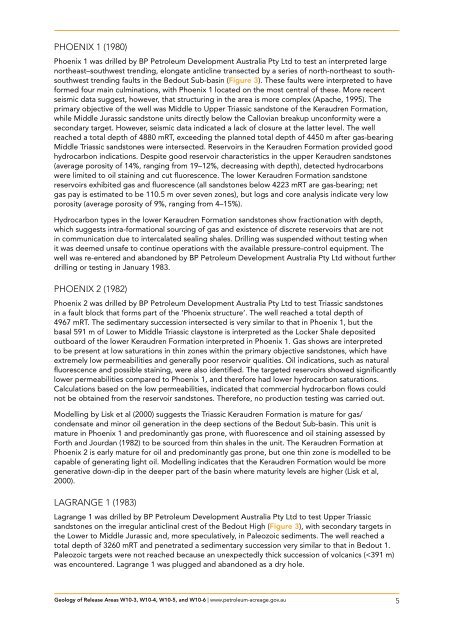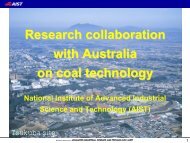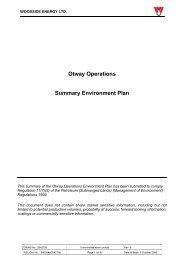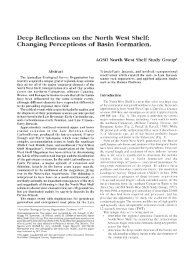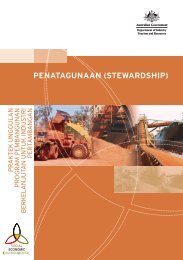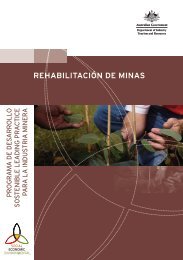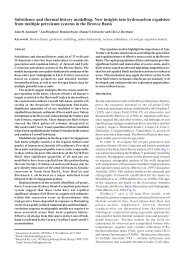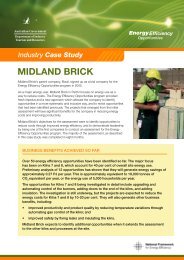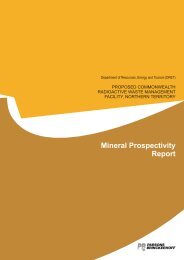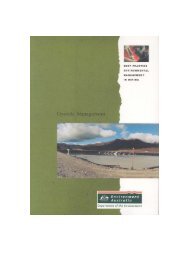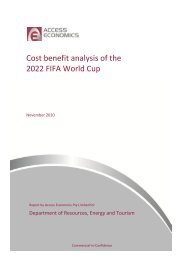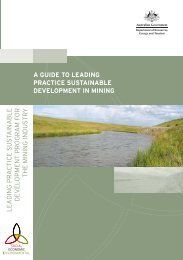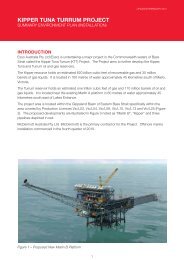Rowley Sub-basin, Roebuck Basin, Release Areas W10-3, W10-4 ...
Rowley Sub-basin, Roebuck Basin, Release Areas W10-3, W10-4 ...
Rowley Sub-basin, Roebuck Basin, Release Areas W10-3, W10-4 ...
You also want an ePaper? Increase the reach of your titles
YUMPU automatically turns print PDFs into web optimized ePapers that Google loves.
PHoenix 1 (1980)<br />
Phoenix 1 was drilled by bP Petroleum development Australia Pty ltd to test an interpreted large<br />
northeast–southwest trending, elongate anticline transected by a series of north-northeast to southsouthwest<br />
trending faults in the bedout sub-<strong>basin</strong> (Figure 3). these faults were interpreted to have<br />
formed four main culminations, with Phoenix 1 located on the most central of these. more recent<br />
seismic data suggest, however, that structuring in the area is more complex (Apache, 1995). the<br />
primary objective of the well was middle to upper triassic sandstone of the Keraudren formation,<br />
while middle Jurassic sandstone units directly below the callovian breakup unconformity were a<br />
secondary target. However, seismic data indicated a lack of closure at the latter level. the well<br />
reached a total depth of 4880 mRt, exceeding the planned total depth of 4450 m after gas-bearing<br />
middle triassic sandstones were intersected. Reservoirs in the Keraudren formation provided good<br />
hydrocarbon indications. despite good reservoir characteristics in the upper Keraudren sandstones<br />
(average porosity of 14%, ranging from 19–12%, decreasing with depth), detected hydrocarbons<br />
were limited to oil staining and cut fluorescence. the lower Keraudren formation sandstone<br />
reservoirs exhibited gas and fluorescence (all sandstones below 4223 mRt are gas-bearing; net<br />
gas pay is estimated to be 110.5 m over seven zones), but logs and core analysis indicate very low<br />
porosity (average porosity of 9%, ranging from 4–15%).<br />
Hydrocarbon types in the lower Keraudren formation sandstones show fractionation with depth,<br />
which suggests intra-formational sourcing of gas and existence of discrete reservoirs that are not<br />
in communication due to intercalated sealing shales. drilling was suspended without testing when<br />
it was deemed unsafe to continue operations with the available pressure-control equipment. the<br />
well was re-entered and abandoned by bP Petroleum development Australia Pty ltd without further<br />
drilling or testing in January 1983.<br />
PHoenix 2 (1982)<br />
Phoenix 2 was drilled by bP Petroleum development Australia Pty ltd to test triassic sandstones<br />
in a fault block that forms part of the ‘Phoenix structure’. the well reached a total depth of<br />
4967 mRt. the sedimentary succession intersected is very similar to that in Phoenix 1, but the<br />
basal 591 m of lower to middle triassic claystone is interpreted as the locker shale deposited<br />
outboard of the lower Keraudren formation interpreted in Phoenix 1. Gas shows are interpreted<br />
to be present at low saturations in thin zones within the primary objective sandstones, which have<br />
extremely low permeabilities and generally poor reservoir qualities. Oil indications, such as natural<br />
fluorescence and possible staining, were also identified. the targeted reservoirs showed significantly<br />
lower permeabilities compared to Phoenix 1, and therefore had lower hydrocarbon saturations.<br />
calculations based on the low permeabilities, indicated that commercial hydrocarbon flows could<br />
not be obtained from the reservoir sandstones. therefore, no production testing was carried out.<br />
modelling by lisk et al (2000) suggests the triassic Keraudren formation is mature for gas/<br />
condensate and minor oil generation in the deep sections of the bedout sub-<strong>basin</strong>. this unit is<br />
mature in Phoenix 1 and predominantly gas prone, with fluorescence and oil staining assessed by<br />
forth and Jourdan (1982) to be sourced from thin shales in the unit. the Keraudren formation at<br />
Phoenix 2 is early mature for oil and predominantly gas prone, but one thin zone is modelled to be<br />
capable of generating light oil. modelling indicates that the Keraudren formation would be more<br />
generative down-dip in the deeper part of the <strong>basin</strong> where maturity levels are higher (lisk et al,<br />
2000).<br />
Lagrange 1 (1983)<br />
lagrange 1 was drilled by bP Petroleum development Australia Pty ltd to test upper triassic<br />
sandstones on the irregular anticlinal crest of the bedout High (Figure 3), with secondary targets in<br />
the lower to middle Jurassic and, more speculatively, in Paleozoic sediments. the well reached a<br />
total depth of 3260 mRt and penetrated a sedimentary succession very similar to that in bedout 1.<br />
Paleozoic targets were not reached because an unexpectedly thick succession of volcanics (


